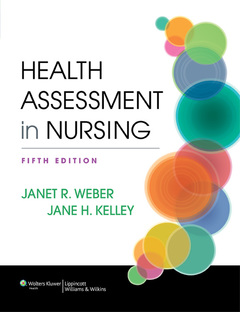Description
Health Assessment in Nursing (5th Ed.)
Authors: Weber Janet R., Kelley Jane H.
Language: English
Subject for Health Assessment in Nursing :
912 p. · 21.3x27.6 cm · Hardback
Out of Print
Description
/li>Contents
/li>
Innovative, systematic, and easy to understand, Health Assessment in Nursing has already helped thousands of RN-level students develop the comprehensive knowledge base and expert nursing assessment skills necessary for accurate collection of client data.
In this revised Fifth Edition, the authors provide in-depth, accurate information, a compelling Continuing Case Study that covers every step in the assessment process, a focus on diversity and health assessment through the lifespan, a striking photo and illustration program that includes photos of practicing registered nurses and nurse practitioners performing assessments, dynamic online video clips and animations, and much more.
Using this book you’ll have everything at your fingertips to master the knowledge and assessment skills you’ll need in your nursing career.
- Master the “how-to’s” of conducting a nursing assessment through the real world Continuing Case Study in every chapter that introduces a client with a health concern, guides you through investigation of symptoms using the COLDSPA mnemonic, and demonstrates a physical assessment, proper documentation techniques, diagnostic reasoning, and appropriate nursing conclusions.
- Access an easy-to-understand tool for data collection with the Collecting Subjective Data: Nursing Health History table, which presents Information in two columns: Questions that you will ask the client and Rationales explaining why the questions are important.
- Master every aspect of the physical examination through the Collecting Objective Data: Physical Examination table, which illustrates physical examination procedures in a step-by-step fashion across three columns: Assessment Procedure (which explains and illustrates exactly how to perform specific aspects of the examination), Normal Findings, and Abnormal Findings.
- Identify important distinctions
Unit 1: Nursing Data Collection, Documentation, and Analysis
Chapter 1
Nurse’s Role in Health Assessment: Collecting and Analyzing Data
Chapter 2
Collecting Subjective Data: The Interview and Health History
Chapter 3
Collecting Objective Data: The Physical Examination
Chapter 4
Validating and Documenting Data
Chapter 5
Thinking Critically to Analyze Data and Make Informed Nursing Judgments
Unit 2: Integrative Holistic Nursing Assessment
Chapter 6
Assessing Mental Status and Substance Abuse
Chapter 7
Assessing Psychosocial, Cognitive, and Moral Development
Chapter 8
Assessing General Status and Vital Signs
Chapter 9
Assessing Pain: The 5th Vital Sign
Chapter 10
Assessing for Violence
Chapter 11
Assessing Culture
Chapter 12
Assessing Spirituality and Religious Practices
Chapter 13
Assessing Nutritional Status
Unit 3: Nursing Assessment of Physical Systems
Chapter 14
Assessing Skin, Hair, and Nails
Chapter 15
Assessing Head and Neck
Chapter 16
Assessing Eyes
Chapter 17
Assessing Ears
Chapter 18
Assessing Mouth, Throat, Nose, and Sinuses
Chapter 19
Assessing Thorax and Lungs
Chapter 20
Assessing Breasts and Lymphatic System
Chapter 21
Assessing Heart and Neck Vessels
Chapter 22
Assessing Peripheral Vascular System
Chapter 23
Assessing Abdomen
Chapter 24
Assessing Musculoskeletal System
Chapter 25
Assessing Neurologic System
Chapter 26
Assessing Male Genitalia and Rectum
Chapter 27
Assessing Female Genitalia and Rectum
Chapter 28
Pulling It All Together: Integrated Head-to-Toe Assessment
Unit 4: Nursing Assessment of Special Groups
Chapter 29
Assessing Childbearing Women
Chapter 30
Assessing Newborns and Infants
Chapter 31
Assessing Children and Adolescents
Chapter 32
Assessing Older Adults
Chapter 33
Assessing Families
Chapter 34
Assessing Communities
Appendices
A: Nursing History Checklist
B: Physical Assessment Checklist
C: NANDA Approved Nursing Diagnoses
D: Selected Collaborative Problems
E: Canada’s Food Guide
Glossary




